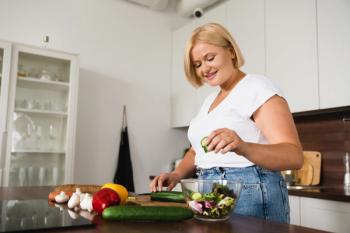
- Nutritional Outlook Vol. 19 No. 9
- Volume 19
- Issue 9
Curcumin Suppliers "Guaranteeing" Natural Curcumin Is Not Synthetic by Using Carbon Dating: SupplySide West Report
Consumer demand for curcumin is skyrocketing, but that demand comes at an unfortunate price-adulteration.
Curcumin is one of the most popular herbal supplements on the U.S. market today, evidenced by booming sales in both the natural and mainstream channels. According to the American Botanical Council’s annual
It’s the classic story of economic adulteration provoked by unbalanced supply and demand, said Mohamed M. Rafi, PhD, founder and CEO of curcumin supplier Bioactives American Corp. (Highland Park, NJ). According to Rafi, the problem with curcumin adulteration has been growing since around 2010 when there was a shortage in curcumin supply.
“Commercial production [of curcumin] remains centered in India, while product demand remains strongest in Europe and North America,” Rafi explained in a Bioactives American white paper discussing natural versus synthetic curcumin. “As such, supply can be somewhat uneven, with some shortages of available ingredient impacted not only by demand but by occasional poor harvests and variable quality. These supply issues have led to the growing problem of adulteration of the available curcumin supply.”
Anurag Pande, PhD, vice president of scientific affairs for curcumin supplier Sabinsa (East Windsor, NJ), indicates that the problem of curcumin spiking in the U.S. may be even more serious than many realize. According to Pande, “Sabinsa recently found that there is quite possibly a sizeable amount of adulteration from synthetic material in the curcumin market in the U.S. and some other parts of the world where such adulteration goes undetected by regular tests.”
A buyer’s first indication that curcumin may be spiked should be price. “The tip-off is curcumin offered at a very low price,” said Pande.
According to Rafi, synthetic curcumin may cost up to half as much as natural curcumin-for instance, $60/kg versus $120/kg.
“The adulteration happens because a part of industry has not realized the risk of sourcing ingredients based on price alone,” Pande added.
If a company suspects curcumin may be adulterated, confirming that fact is no easy task, however, because many test methods, including DNA testing, cannot differentiate synthetic and natural curcumin. And that’s because adulterers have gotten very good at mimicking the real thing.
“Natural turmeric-derived samples usually contain a mixture of curcumin (about 75%–80%), demethoxycurcumin (about 15%–20%), and didemethoxycurcumin-also known as bisdemethoxycurcumin (below 5%),” Rafi explained in the Bioactives white paper. Together, these three curcuminoids comprise curcumin’s key active constituents. This standard mixture is commonly known in the industry as “curcumin 95%.”
When natural curcumin is tested using high-performance liquid chromatography (HPLC), these three curcuminoids register as specific peaks. The problem is that adulterers are now able to create synthetic curcumin that will also register these same three peaks. “The synthetic adulteration unfortunately is difficult to find by regular analysis as it does not leave any chemical fingerprint which can be analyzed, neither can it be detected by a DNA test,” said Sabinsa’s Pande.
Instead, some curcumin suppliers are now turning to radiocarbon dating. Natural curcumin extracts contain carbon 14, a radioactive isotope of carbon. Plants naturally contain carbon 14 (also called simply “radiocarbon”) because it is part of the carbon dioxide that plants take in from the atmosphere during photosynthesis. Synthetic curcumin, which is created using petrochemicals/fossil fuel, does not contain carbon 14. Using carbon dating (C14 testing) via methods like accelerator mass spectrometry, analysts look for the presence of carbon 14 to confirm that an ingredient is, in fact, from a natural source.
Pande said that Sabinsa was the first company to begin testing curcumin using this method of carbon dating, which was developed by the University of Georgia’s Center for Applied Isotope Studies (Athens, GA).
“When Sabinsa found the possibility of synthetic adulteration in the market, we started looking for ways to ensure that our customers are not exposed to that risk,” he said. “We collaborated with the University of Georgia to find a solution. We also
“We welcome other companies following Sabinsa’s lead to test their products by C14 and help weed out the problem of adulteration,” he added. Sabinsa said it is now using C14 testing on its entire range of Curcumin C3 Complex natural-curcumin products to guarantee that it’s natural.
Bioactives American is also using C14 testing. At SupplySide West, the company promoted its Curcuzen 95% natural curcumin ingredient. Rafi said the company guarantees that Curcuzen will always be authenticated using C14 testing. “Every batch of Curcuzen goes through the University of Georgia for C14 testing and will be 100% natural,” Rafi said.
Curcumin purchasers should consider using C14 testing if they aren’t already to determine whether the ingredient they are buying is 100% natural curcumin, or if it is synthetic or even a mixture of natural and synthetic curcumin (which C14 testing can also reveal). According to Sabinsa, several commercial labs have adopted the test method.
Beware Synthetic
What’s the harm in synthetic curcumin? As Rafi pointed out in the white paper, synthetic curcumin ingredients “have not been tested for safety and pharmacological activity.” And, he said, synthetic and natural curcumin “are not interchangeable for pharmacological activities”-meaning that the health benefits that science has so far ascribed to natural curcumin, including antioxidant and anti-inflammatory properties, cannot be attributed to synthetic curcumin as well. “Nature versus synthetic-the health benefits will be different,” he said.
More significantly, Rafi said, synthetic curcumin may actually be harmful. “When you do synthetic, a lot of toxic residues will be there, like benzene,” he said. “Benzene is very toxic, cancer causing. Then solvents. Natural curcumin will never use any harsh solvents. We use ethanol, ethyl acetate, acetone. These are the solvents that are used for natural extraction. We never use ethylene dichloride. But synthetic curcumin is completely from petrochemicals.”
In addition to synthetic curcumin’s unproven efficacy, Pande pointed out that there can be serious regulatory consequences to using synthetic curcumin. “[Synthetic] curcumin can cause serious risks to health, and it is also illegal as per FDA’s [new dietary ingredient] guidance documents and [the agency’s] longstanding position that a synthetic is not the same as a botanical. Further, it is a federal crime to expose the consumers to the risk of synthetic compounds, which have no safety studies.” FDA’s new dietary ingredient draft guidance, released on August 11, states that, “Under a plain reading of the FD&C Act, a synthetic copy of an herb or other botanical does not qualify as a dietary ingredient under section 201(ff)(1)(C) of the FD&C Act. As defined in the glossary, an herb or botanical includes only plants, algae, fungi, their exudates (secretions, such as sap or resin), and their physical parts. A substance that has been synthesized in a laboratory or factory has never been part of an herb or other botanical and, therefore, is not a dietary ingredient under section 201(ff)(1)(C) of the FD&C Act.”
Pande pointed out that Sabinsa has led the way by taking action against adulterers. “Sabinsa was the first and only supplier in the market to highlight the synthetic adulteration issue with regard to curcumin by initiating and publicizing several lawsuits against companies knowingly supplying synthetic versions but calling it natural. No other supplier, or trade association for that matter, has taken companies to court like Sabinsa has.” One of those companies is Bayir Extracts Private Ltd., an India-based firm against whom Sabinsa filed a criminal complaint in 2015, alleging that Bayir had “knowingly” supplied Sabinsa with curcumin that was 43% synthetic along with a forged Certificate of Analysis.
Vigilance Needed in Other Areas, Too
Guarding against curcumin adulteration also begins at the very start of the supply chain, said Timothée Olagne, business development manager and marketing director, nutrition and health, for Naturex (Avignon, France). Naturex supplies curcumin, too. Olagne said that Naturex is also aware of adulteration issues in the market. He said his firm has performed carbon testing to detect synthetics, although it does not perform the testing on a “systematic basis.” But, said Olagne, the company is confident in the authenticity of its supply because it has a strong traceability system that reaches all the way back to where the turmeric is grown.
“Identification is not a one-way process,” Olagne said. “There are different methods. I think traceability and controlling the source is another one.” He added that “the customer that comes to Naturex, they are going there because they know that it’s from nature. So it’s not that we don’t know what’s happening in the world market. What we know is what we’re doing, and we have good traceability.”
Working with a reputable ingredient supplier is key to guarding against adulteration, these suppliers said. “Marketing companies must be more careful choosing suppliers or at least test for source identity,” Pande said. “Unfortunately, not all brands do their due diligence and thus end up having spurious curcumin in their product, risking the brand name, industry credibility, and consumer health all at the same time.”
Consumers themselves should also be wary, Rafi said. “When you look at the pricing of the finished product, some companies are selling 60 curcumin capsules for $7. It’s not possible.” The wide cost discrepancy on the market for finished curcumin supplements, which can range anywhere from $7–$60, already indicates there is a problem, he said.
The bottom line is that although consumers and supplement makers may be attracted to lower-priced curcumin, they should not operate on price alone. “It’s not possible to buy curcumin from India for less than $100/kg,” Rafi said. “The price should be around $120-$130.” If buyers start seeing prices in the $60 range, then they should be wary, he said.
Because ultimately, if a firm ends up facing the serious consequences of using synthetic curcumin, “one may ask if such cost savings was wise at all," Pande said.
Curcumin suppliers like Sabinsa and Bioactives are now intent on getting the message out about the risks of synthetic curcumin in order to protect their stake in the natural-curcumin industry. As Pande said, “the ultimate price of such product is paid by the whole industry in the form of lack of trust from consumers.”
“It is a problem which the industry has to face on a united front,” he said.
Also read:
Editor-in-Chief
Nutritional Outlook magazine
jennifer.grebow@ubm.com
Articles in this issue
about 9 years ago
Are Omega-3 Supplements Heart-Healthy?about 9 years ago
Brain Health and Sports Nutrition Team Up in Dietary Supplementsabout 9 years ago
Stevia's Growth Marketsabout 9 years ago
Capsule and Softgel Advancements for Dietary SupplementsNewsletter
From ingredient science to consumer trends, get the intel you need to stay competitive in the nutrition space—subscribe now to Nutritional Outlook.





